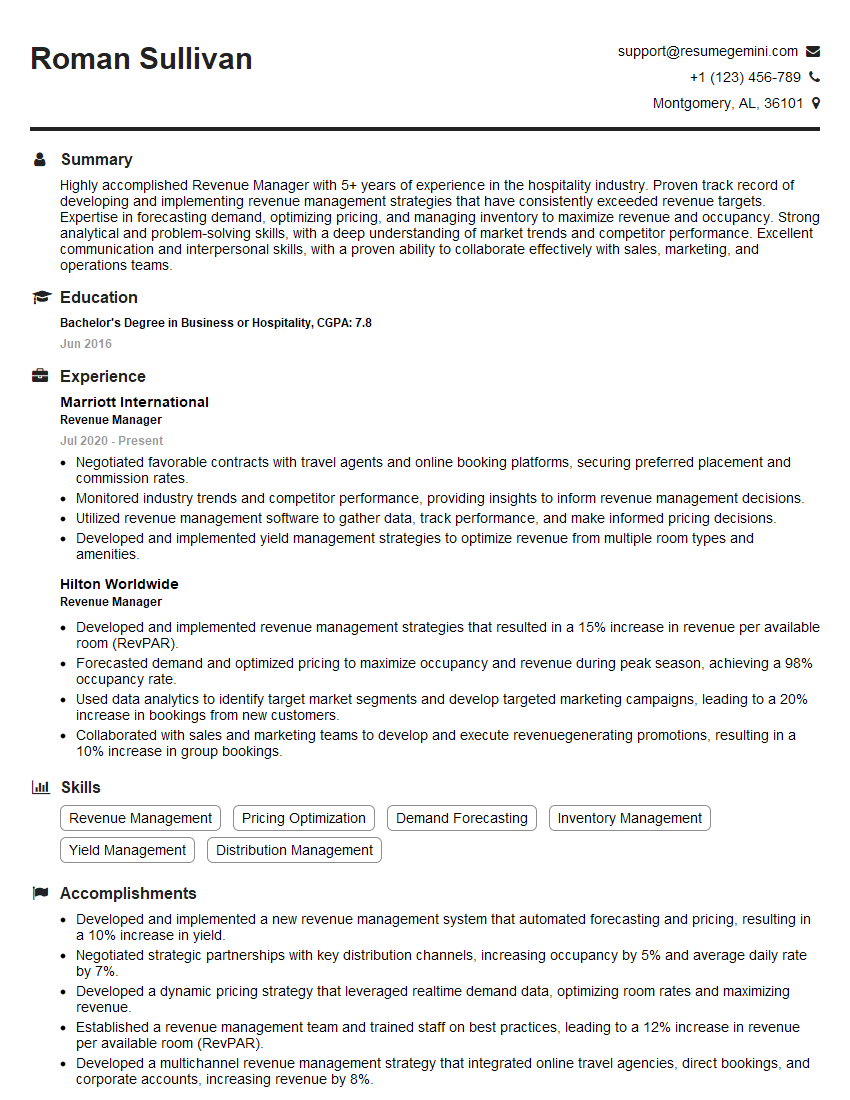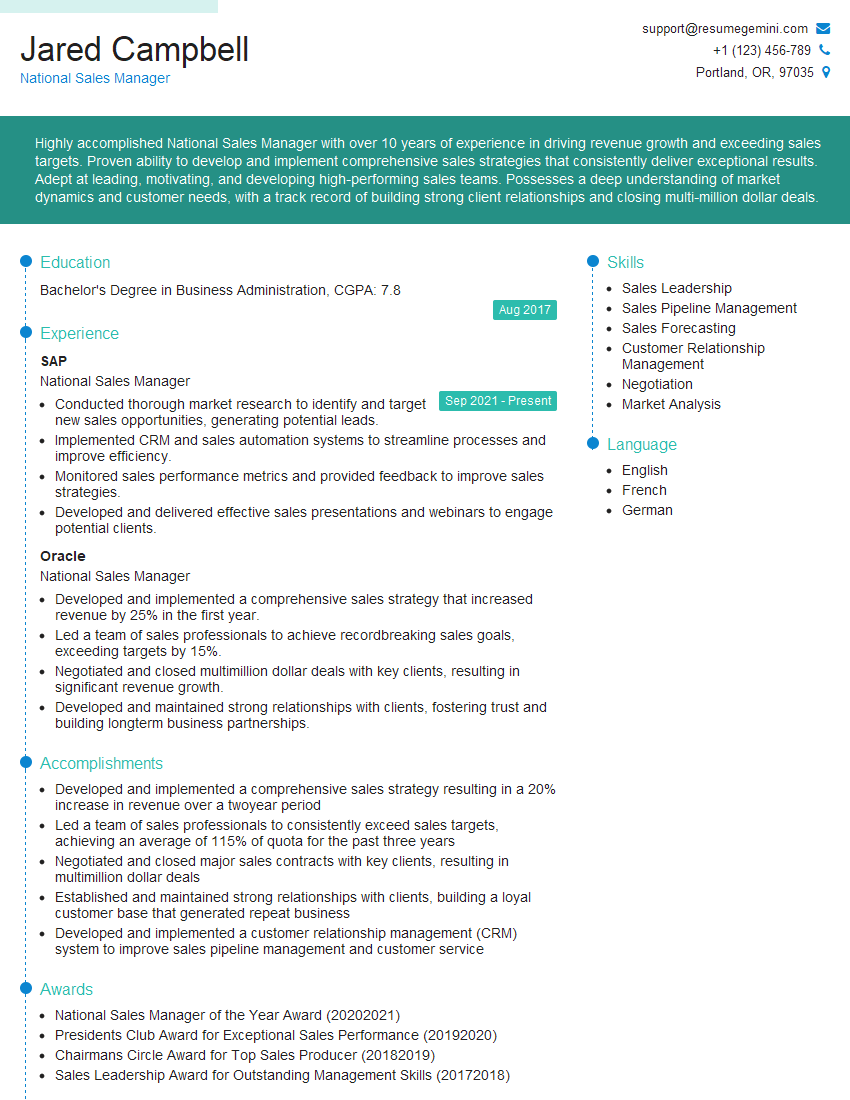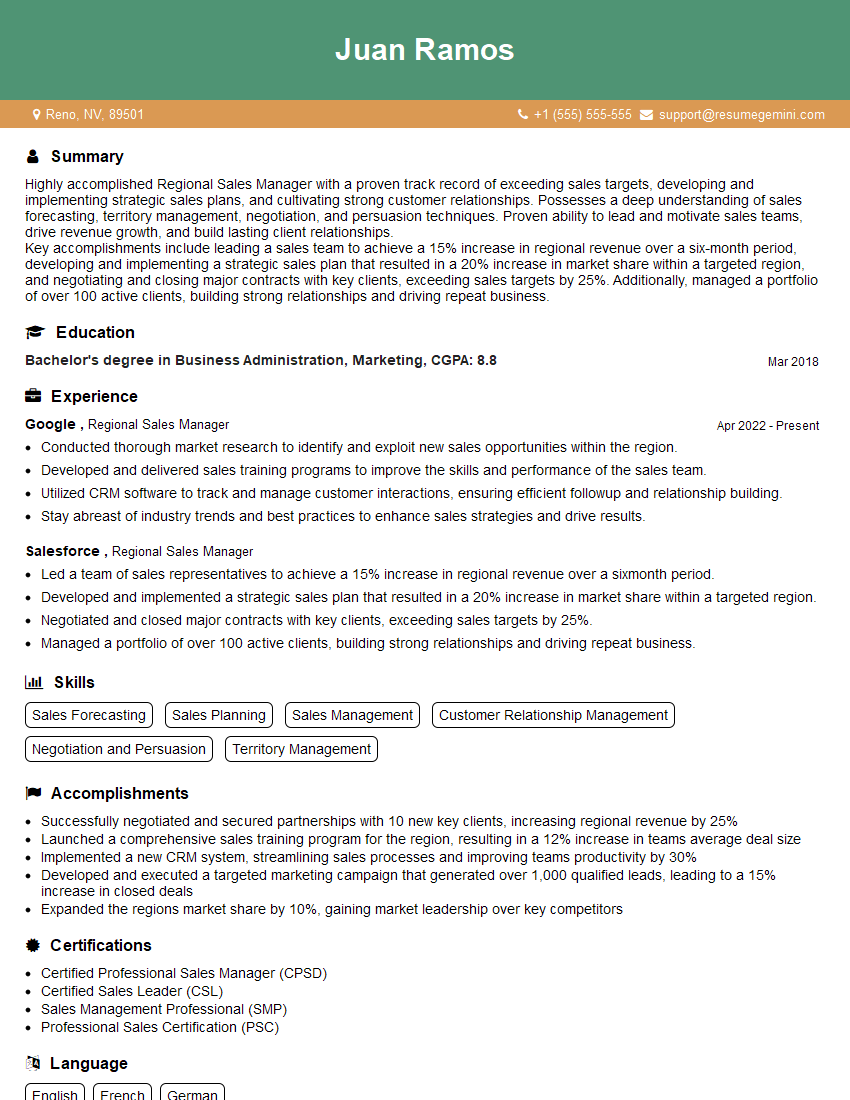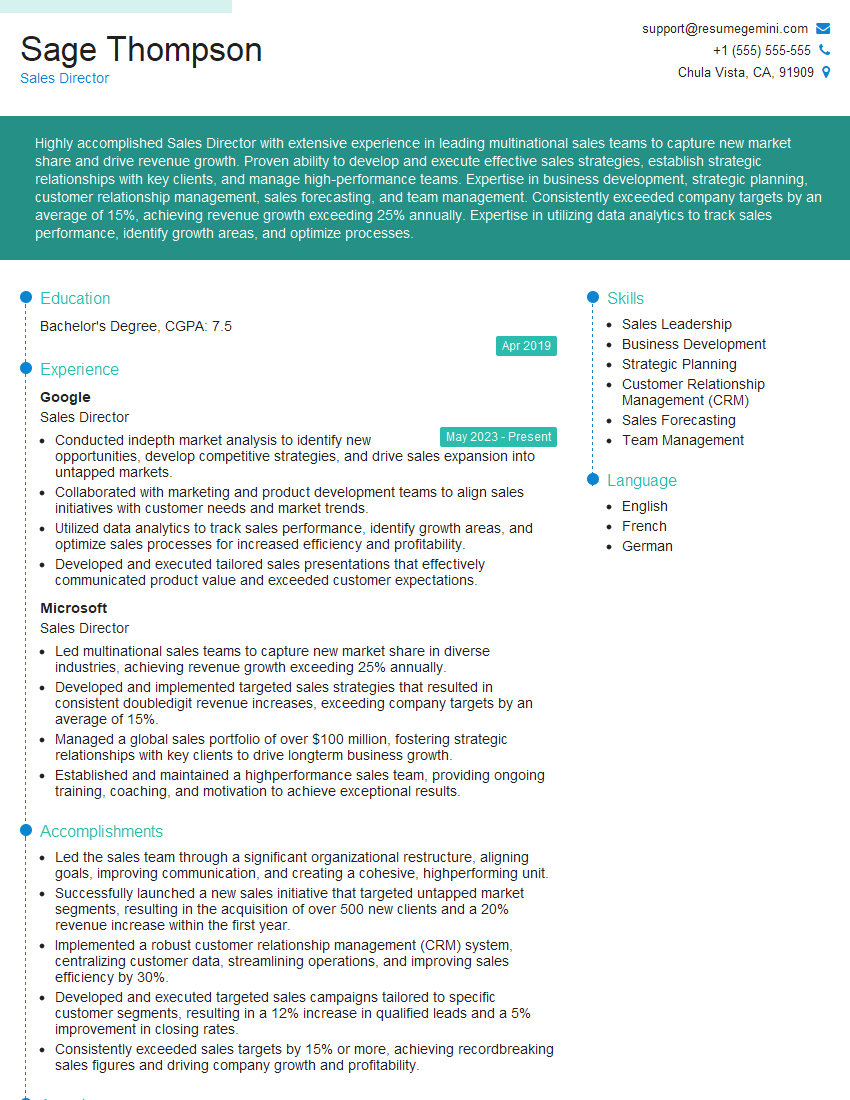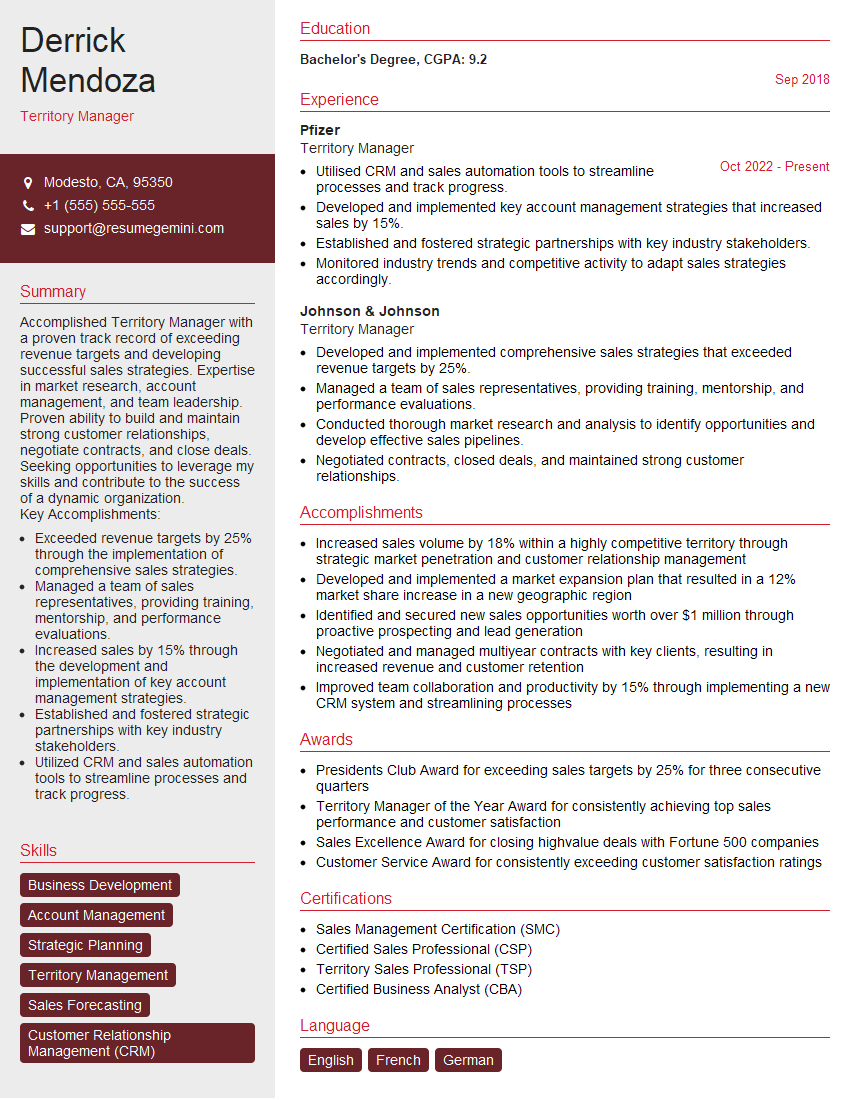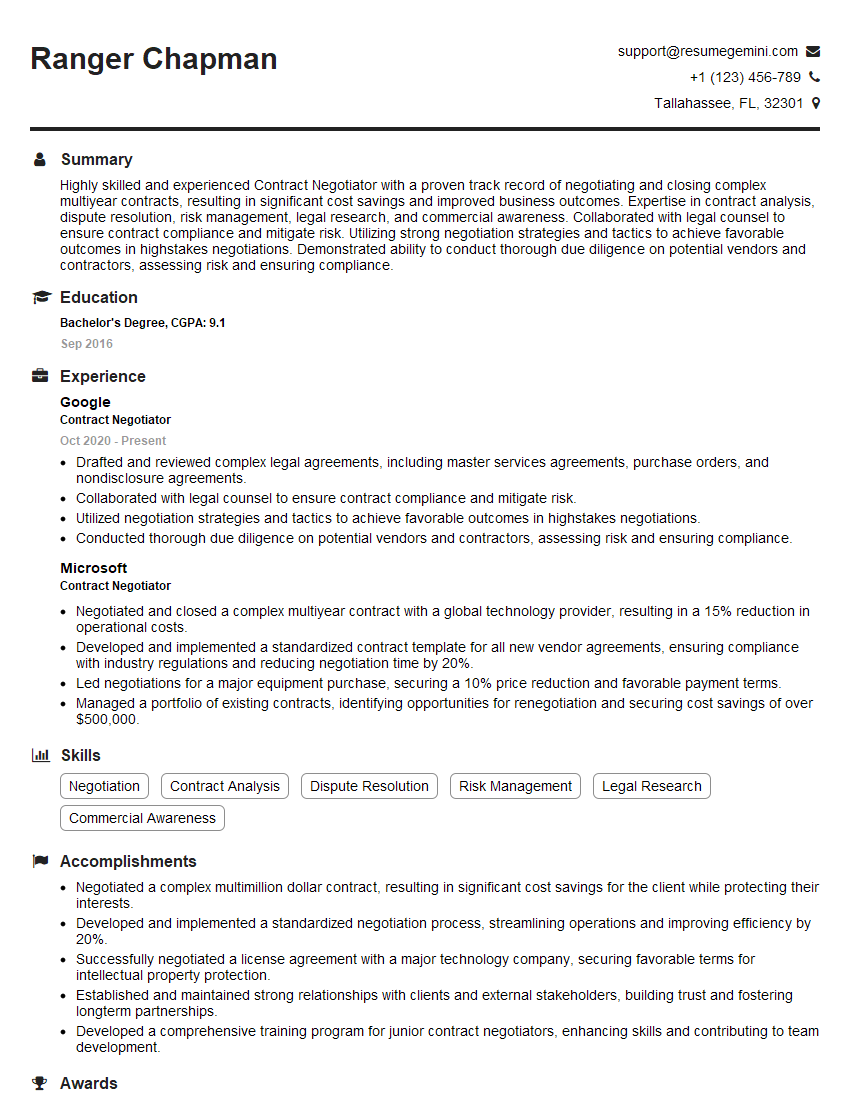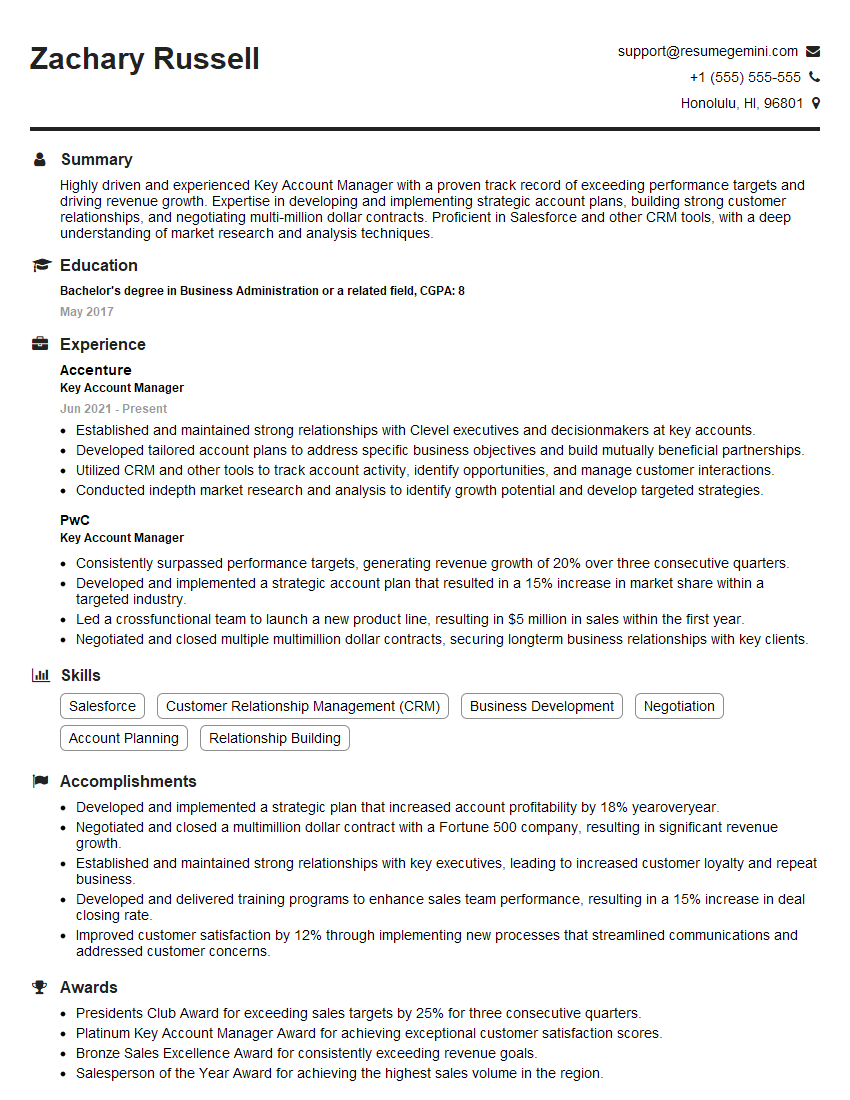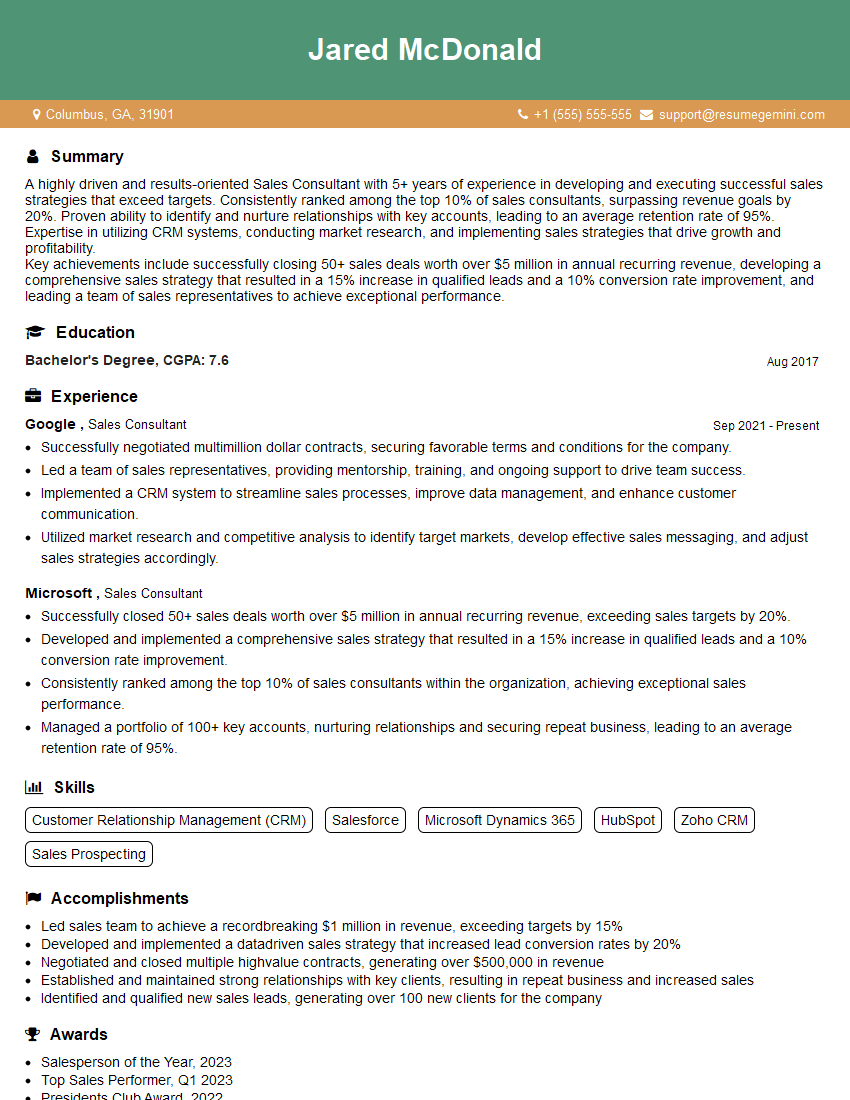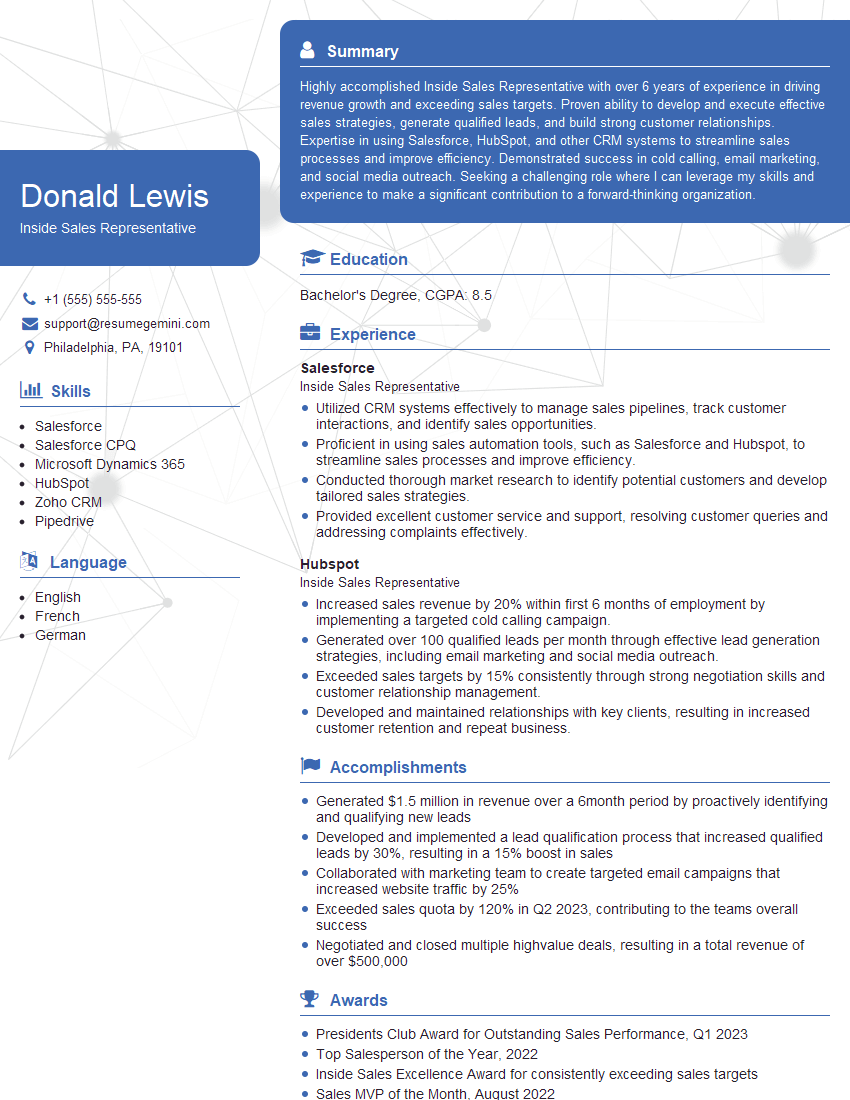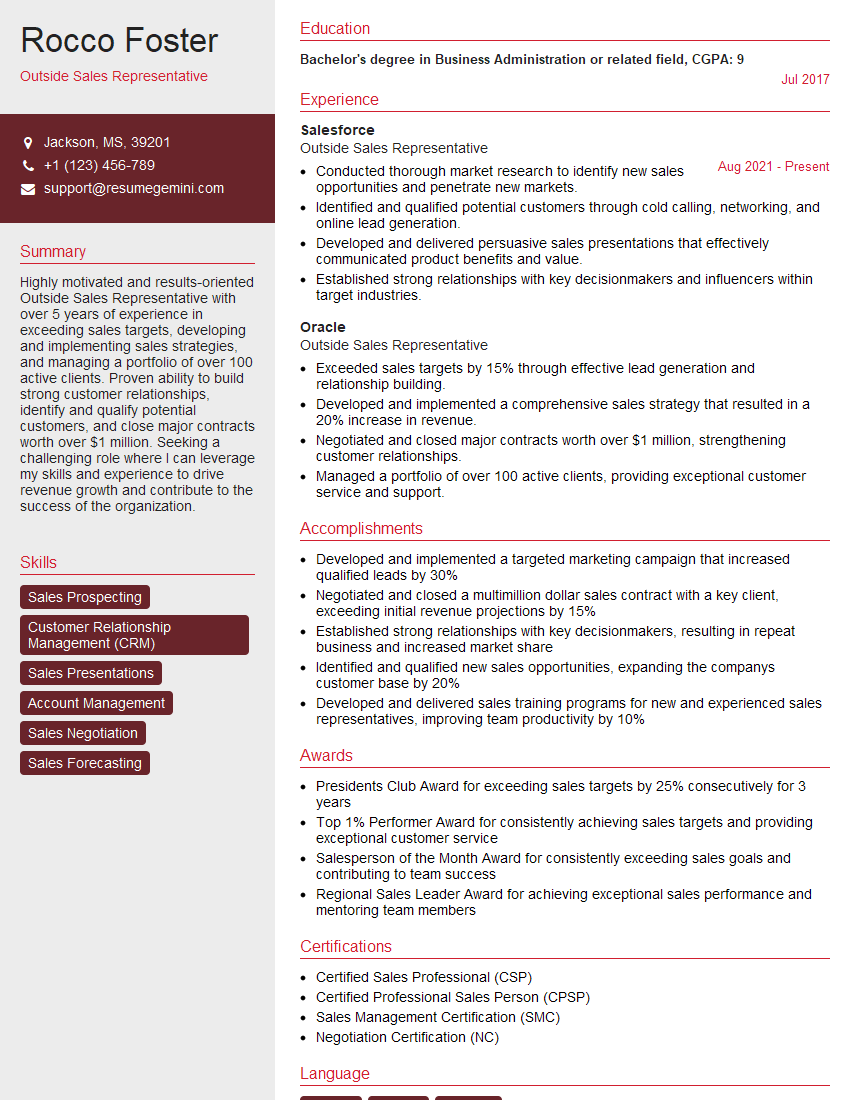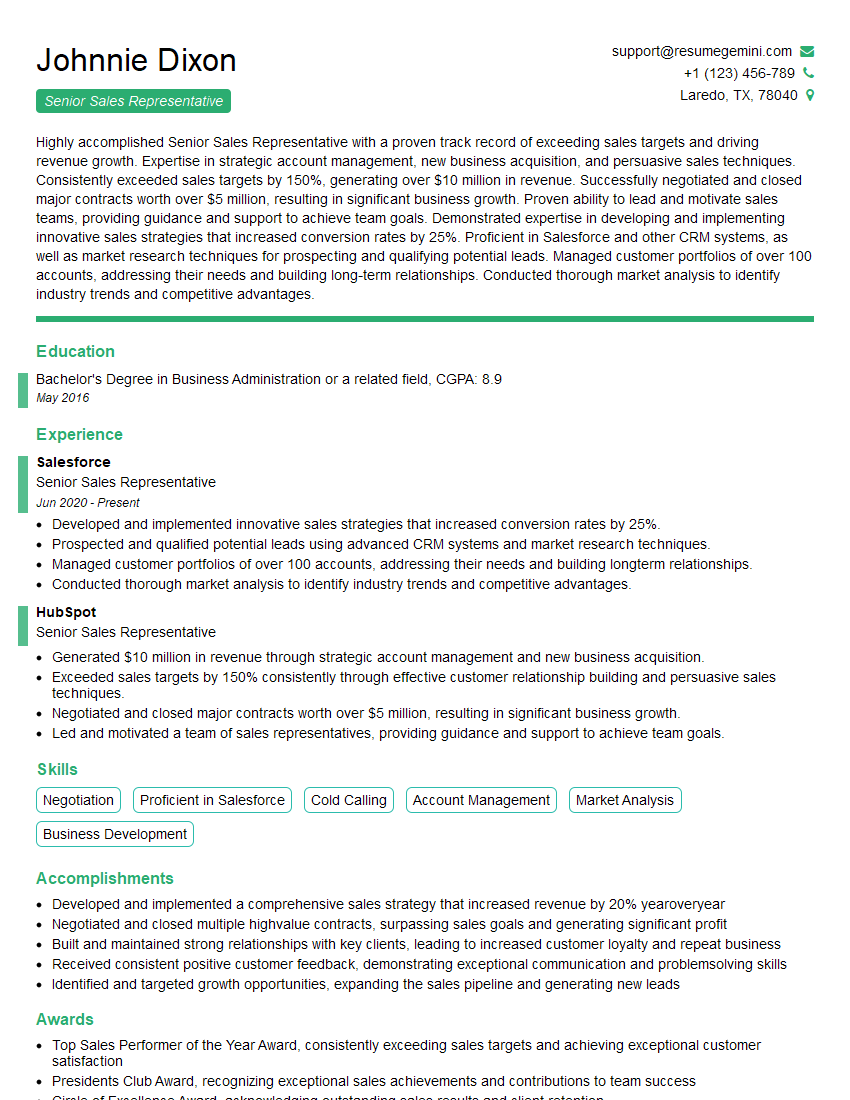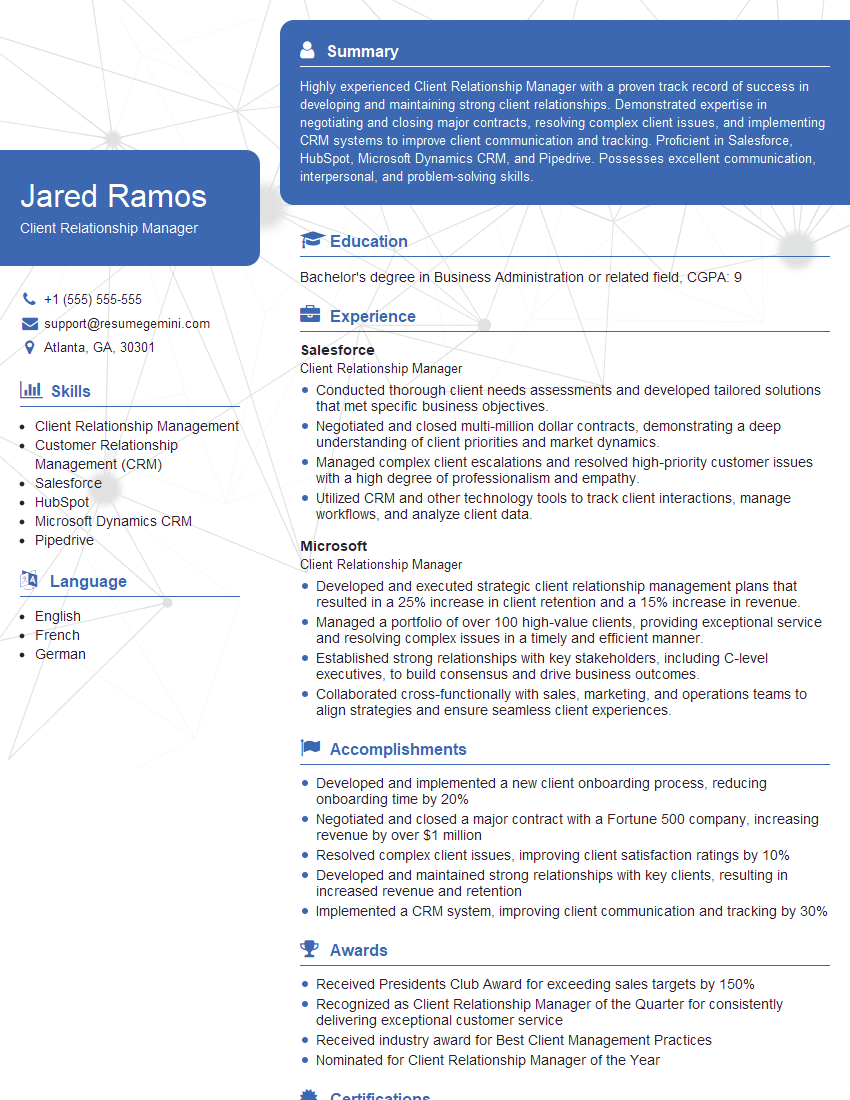Unlock your full potential by mastering the most common Closing Statements interview questions. This blog offers a deep dive into the critical topics, ensuring you’re not only prepared to answer but to excel. With these insights, you’ll approach your interview with clarity and confidence.
Questions Asked in Closing Statements Interview
Q 1. Explain the importance of a strong closing statement in sales.
A strong closing statement is the cornerstone of a successful sale. It’s the culmination of your efforts, the moment you ask for the commitment. A poorly executed close can lose a deal, even if you’ve done everything else perfectly. A strong close, however, confidently summarizes the value proposition, addresses any lingering concerns, and smoothly guides the prospect toward a decision. It’s the difference between a sale and a lost opportunity. Think of it as the final push in a marathon – you’ve run the distance, but need that final burst to cross the finish line.
Q 2. Describe your process for identifying the optimal moment to deliver a closing statement.
Identifying the optimal closing moment is crucial. It’s not about forcing a sale, but recognizing when the prospect is ready. My process involves carefully observing their behavior and responses. Do they ask clarifying questions that show genuine interest? Are they actively participating in the conversation and engaging with the product details? Have their initial objections been addressed? A positive body language (leaning forward, nodding frequently) coupled with verbal cues (excited tone, positive comments) is a strong indicator. I use a combination of active listening and subtle probing questions to gauge their readiness. I often use trial closes – smaller commitment requests like, “Does this timeline work for you?” or “Are you excited about the potential benefits?” – to test the waters before attempting the main close.
Q 3. What are three common objections you encounter during the closing process, and how do you address them?
Three common objections I face are price, need, and trust.
- Price: This is often addressed by reframing the price in terms of value and return on investment. I might highlight the long-term benefits, compare the cost to competitors, or offer financing options. For instance, “While the initial investment is higher, consider the significant increase in efficiency and cost savings over the next three years.”
- Need: This is tackled by demonstrating how the product or service solves a specific problem or meets a critical need. I might ask probing questions to uncover their underlying challenges, then show how my offering directly addresses those issues. For example, “I understand you’re currently struggling with X. Our solution directly targets this by providing Y and Z.”
- Trust: Building trust involves providing testimonials, case studies, and emphasizing my expertise and experience. Showing credibility and transparency builds confidence. I might say, “Our company has a proven track record of success in this area, with over 95% client satisfaction.”
Q 4. How do you tailor your closing statement to different client personalities or situations?
Tailoring the closing statement is essential for maximizing success. I adapt my approach based on the client’s personality and situation. A decisive client might respond well to a direct, confident close, while a more cautious client may need a more consultative approach. For example, a detail-oriented client will appreciate a comprehensive summary of benefits and features, whereas a results-oriented client would focus on the bottom-line ROI. I adjust my communication style, tone, and the pace of the conversation to create rapport and resonate with each individual.
Q 5. How do you handle a situation where a client is hesitant to commit?
Hesitation often indicates unresolved concerns or a need for reassurance. I address this by actively listening to their hesitations and asking open-ended questions to understand their concerns. I might reiterate the key benefits, address any lingering objections, or offer additional support or resources to alleviate their uncertainty. Sometimes, simply providing a clear next step, like scheduling a follow-up call to answer further questions, can be enough to overcome their hesitancy. I never pressure them, but instead focus on providing them with the information and support they need to feel confident in their decision.
Q 6. Describe a time you successfully closed a deal despite facing significant challenges.
I once had a challenging close with a large corporation. They had specific technical requirements that were difficult to meet within their tight budget. The initial quote was significantly above their expected range. Instead of immediately discounting, I spent extra time understanding their technological needs and budget limitations. We then collaborated to identify cost-effective solutions that still met their technical requirements. This involved suggesting phased implementation, exploring alternative technologies, and negotiating flexible payment terms. This collaborative approach turned a potential lost deal into a successful partnership, proving that building trust and understanding client needs often overcomes seemingly insurmountable obstacles.
Q 7. What are some effective techniques for overcoming price objections?
Overcoming price objections requires reframing the conversation around value. Techniques include:
- Highlighting Value Added: Focus on the long-term benefits, cost savings, or increased efficiency the product/service provides.
- Offering Packages or Bundles: Present different packages at various price points, offering better value for money.
- Financing Options: Provide options like installment plans or leasing to make the initial investment more manageable.
- Demonstrate ROI: Quantify the return on investment, showing the client how the cost will be recouped and exceeded.
- Comparison Shopping: Compare your prices to competitors, highlighting your product’s superior quality or features.
The key is to shift the focus from the price itself to the overall value and return the client will receive.
Q 8. How do you build rapport and trust with a client to facilitate a successful close?
Building rapport and trust is paramount for a successful close. It’s about establishing a genuine connection with the client, making them feel understood and valued. This goes beyond just selling; it’s about building a relationship. I achieve this through active listening, showing empathy, and understanding their needs and concerns. I start by asking open-ended questions to learn about their situation and goals, focusing on their specific challenges. I then tailor my presentation to address those needs, demonstrating how my solution directly benefits them. I also prioritize transparency and honesty throughout the process, managing expectations effectively. For instance, if a certain feature isn’t available, I’ll explain why and offer an alternative solution instead of misleading the client. Finally, building trust means being responsive and available to answer questions promptly and thoroughly. A simple follow-up call or email can go a long way in reinforcing the relationship and showing you care.
Q 9. Explain the difference between a hard close and a soft close. When is each appropriate?
A hard close is a direct and assertive attempt to secure the sale immediately. It involves directly asking for the commitment, like “So, are you ready to move forward today?” A soft close, on the other hand, is a more subtle and indirect approach. It gauges the client’s readiness without explicitly asking for a decision. This could involve asking questions like, “What are your biggest concerns about moving forward?” or summarizing the benefits and asking for confirmation that everything is understood. A hard close is appropriate when the client has shown clear interest and has few remaining questions. A soft close is best when the client still needs more information or time to consider their options. Using the wrong approach can be detrimental, pushing the client away in the case of a premature hard close, or losing a sale by being too tentative with a soft close. The key is to read the client’s cues and adapt your approach accordingly.
Q 10. What are the key components of a compelling closing statement?
A compelling closing statement concisely summarizes the key benefits, addresses any remaining concerns, and provides a clear call to action. It should reiterate the value proposition and highlight the unique selling points. Think of it as a concise recap of the entire sales process, focused on the client’s needs and how your solution solves them. Key components include: a brief reminder of the problem being solved, a clear articulation of the solution offered and its benefits (preferably quantifiable where possible), a confident and positive tone, a concise summary of next steps, and a clear call to action with multiple options (e.g., “Shall we schedule the installation for next week? Or would you prefer to review the contract in more detail first?” ). It should avoid high-pressure tactics and instead focus on building consensus and mutual agreement.
Q 11. How do you handle a client who requests additional information before committing?
Handling requests for additional information before a commitment requires patience and professionalism. I approach this by actively listening to their questions and providing thorough answers. This may involve pulling in additional resources, such as technical specifications or case studies. The key is to demonstrate expertise and build further trust. I’ll also address any concerns they may have, proactively addressing potential objections before they become major roadblocks. Sometimes, a simple visual aid or a relevant example can effectively resolve uncertainty. If the additional information needed requires significant research, I will set clear expectations on the timeframe and maintain open communication to keep the client informed of the progress. For example: “I understand you’d like more data on feature X. I can provide that to you by [timeframe]. Would you prefer a call or email update?” This maintains a professional and proactive approach, showcasing my commitment to client satisfaction.
Q 12. Describe your experience with different closing techniques (e.g., summary close, assumptive close, question close).
I’m proficient in various closing techniques and adapt my approach based on the client’s personality and the specific sales situation. The summary close effectively recaps the benefits and key selling points. The assumptive close presumes the client will purchase, focusing on details like delivery or payment options. For example, “Now that we’ve covered everything, what date would work best for delivery?” The question close uses open-ended questions to identify and overcome any objections. For example, “Is there anything that is still preventing you from moving forward today?” I frequently combine these techniques for a more comprehensive approach. For example, I may start with a summary close to reaffirm the value, then use a question close to address any lingering concerns, and finally, an assumptive close to finalize the sale if the client is ready. The selection depends entirely on the nuances of the client and the negotiation.
Q 13. How do you measure the effectiveness of your closing statements?
I measure the effectiveness of my closing statements using a multi-faceted approach. Firstly, I track my overall closing rate, comparing the number of successful closes against the total number of presentations. Secondly, I analyze client feedback, both positive and negative, to identify areas for improvement. Post-sale surveys or informal conversations can provide valuable insights. Thirdly, I review sales call recordings to analyze my communication style, identify areas where I could have been more effective, and refine my closing techniques accordingly. This iterative process helps me continually optimize my approach and improve my closing success rate over time. Finally, I also analyze which closing techniques are most effective for different client segments.
Q 14. What metrics do you use to track your closing success rate?
I track several key metrics to evaluate my closing success rate. The primary metric is the closing rate, calculated as the number of successful closes divided by the total number of opportunities. I also track the average deal size, reflecting the value of each successful transaction. Additionally, I monitor conversion rates at various stages of the sales funnel, to identify bottlenecks and areas for improvement. For example, I’ll track the percentage of leads that convert into qualified prospects, the percentage of prospects who move into the proposal stage, and the percentage of proposals that convert into closed deals. Finally, I analyze customer acquisition cost (CAC), balancing the closing rate with the cost of acquiring each new customer. This provides a holistic view of closing efficiency and profitability.
Q 15. How do you use a closing statement to transition into post-sales support?
A successful closing statement isn’t just about securing the sale; it’s the bridge to a long-term relationship. I use the closing process to seamlessly transition into post-sales support by explicitly outlining the next steps and emphasizing ongoing value. For example, I might say something like, “Congratulations on your purchase! Now that we’ve finalized this, let’s schedule a brief onboarding call next week to ensure you’re comfortable with the system. We’ll also be sending you a welcome packet with helpful resources and FAQs.”
This approach proactively addresses potential issues, reinforces the value of the purchase, and sets clear expectations for ongoing support. It avoids abrupt closure and instead positions post-sales interaction as a natural continuation of the positive buying experience. I also mention specific contacts and timelines for responsiveness to any questions, fostering trust and building a strong client relationship. This proactive approach transforms the closing from a transactional endpoint into the initiation of a valuable, ongoing partnership.
Career Expert Tips:
- Ace those interviews! Prepare effectively by reviewing the Top 50 Most Common Interview Questions on ResumeGemini.
- Navigate your job search with confidence! Explore a wide range of Career Tips on ResumeGemini. Learn about common challenges and recommendations to overcome them.
- Craft the perfect resume! Master the Art of Resume Writing with ResumeGemini’s guide. Showcase your unique qualifications and achievements effectively.
- Don’t miss out on holiday savings! Build your dream resume with ResumeGemini’s ATS optimized templates.
Q 16. How do you handle a situation where a client declines your offer?
When a client declines my offer, I focus on understanding their reasoning, not on pressuring them. I thank them for their time and ask open-ended questions like, “What aspects of the proposal did not meet your needs?” or “Could you tell me more about why you’re choosing a different option?” This approach allows me to learn and improve my sales strategy.
Even if the sale is lost, I maintain professionalism. I always aim to leave a positive impression, offering to stay in touch for future opportunities or to answer any questions they might have down the line. This approach often leads to referrals or future business. For example, I may say, “While I’m disappointed we didn’t reach an agreement this time, I value your candid feedback. I’d welcome the opportunity to discuss your needs again in the future should your circumstances change.” This shows respect for the client’s decision and keeps the door open for future possibilities.
Q 17. What are some ethical considerations related to closing statements?
Ethical considerations in closing statements are paramount. Transparency and honesty are key. I avoid misleading statements or high-pressure tactics. I ensure all claims are accurate and backed by evidence. If I don’t have complete information, I don’t fabricate it; instead, I clearly communicate that I will find the answer and follow up.
Protecting client data and respecting privacy is also critical. I never share client information without their explicit consent. Furthermore, I uphold fair competition by avoiding practices like defamation or disparagement of competitors. I ensure all agreements are clearly understood by both parties before finalizing the deal and I maintain detailed records of all communication and agreements.
Q 18. How do you adapt your closing strategy for different sales channels (e.g., phone, email, in-person)?
My closing strategy adapts significantly based on the sales channel. In-person interactions allow for building rapport and immediate feedback; I might use more visual aids and demonstrations, relying on body language to gauge reactions. Phone calls require clear and concise language, focusing on active listening and addressing concerns immediately. Emails need a professional and well-structured approach, utilizing bullet points, concise sentences, and a strong call to action.
For example, an in-person closing might incorporate a personalized presentation and a hands-on demonstration, whereas a phone call would emphasize clear articulation of benefits and handling objections efficiently. An email would focus on highlighting key selling points with a clear and concise call to action. The core principles of honesty, clarity, and addressing client concerns remain constant across all channels, but the delivery method must be tailored for optimal impact.
Q 19. Describe a time you failed to close a deal. What did you learn from the experience?
I once failed to close a deal because I focused too heavily on features instead of benefits. I presented a technically impressive product, but I didn’t effectively connect it to the client’s needs. I spent too much time discussing specifications and overlooked the client’s underlying business challenges. The client felt overwhelmed with technical jargon and didn’t see the value proposition clearly.
The crucial lesson learned was the importance of understanding the client’s perspective and framing the sale around their needs and desires. I now prioritize active listening, asking clarifying questions to thoroughly understand the client’s goals and concerns before even presenting the product. I learned to translate technical features into tangible benefits that directly address their pain points, making the value proposition immediately clear and compelling.
Q 20. How do you integrate closing statements into your overall sales strategy?
Closing statements aren’t an isolated event but an integral part of the overall sales strategy. They’re the culmination of a well-structured process that begins with qualification, needs assessment, and value proposition. My sales strategy prioritizes building strong relationships and understanding client needs, setting the stage for a natural and persuasive closing.
I integrate closing statements into the sales process by practicing consistent value reinforcement throughout each stage, addressing concerns proactively and aligning the final offer with the client’s established needs and expectations. This approach transforms the closing from a high-pressure event to a confirmation of a mutually beneficial agreement.
Q 21. What tools or technologies do you utilize to support the closing process?
I utilize several tools to support the closing process. CRM (Customer Relationship Management) systems like Salesforce help me track client interactions, manage proposals, and streamline communication. Presentation software like PowerPoint or Google Slides allows me to create engaging visuals to support my closing pitch. E-signature tools like DocuSign enable efficient contract signing, streamlining the finalization of agreements.
Data analytics dashboards provide insights into sales trends and client preferences, helping me refine my closing strategies. These tools, used together, empower me to personalize the closing experience, respond effectively to client needs and ultimately increase closing rates and the overall efficiency of the sales process.
Q 22. How do you maintain professionalism and build trust during the closing phase?
Maintaining professionalism and building trust during the closing phase is paramount. It’s the culmination of the entire sales process, and a shaky closing can undo all the previous hard work. My approach centers around consistent communication, transparency, and a genuine desire to serve the client’s best interests.
- Consistent Communication: I keep clients updated every step of the way, proactively addressing any questions or concerns before they escalate. This involves regular check-ins, clear explanations of documentation, and prompt responses to inquiries. For example, if there’s a delay in paperwork, I’ll immediately inform the client, explaining the reason and providing a realistic timeframe for resolution.
- Transparency: I believe in full disclosure. I clearly explain all fees, terms, and conditions, leaving no room for misunderstanding. This includes providing detailed breakdowns of costs and answering questions frankly and honestly, even if the answer isn’t what the client wants to hear. Honesty builds credibility.
- Empathy and Active Listening: I actively listen to the client’s concerns and respond with empathy, validating their feelings. This shows that I value their perspective and am committed to finding solutions that meet their needs. I try to see things from their point of view and understand their priorities.
By consistently demonstrating professionalism, transparency, and empathy, I cultivate a strong rapport with clients, fostering trust and paving the way for a smooth and successful closing.
Q 23. Explain the concept of ‘value proposition’ and how it relates to closing statements.
The ‘value proposition’ is the core benefit your product or service offers to a client. In the context of closing statements, your value proposition isn’t just about the product itself; it’s about the overall solution you’ve provided and the value it brings to the client’s life. It’s about proving that your solution solves their problem or fulfills their need better than any alternative.
In closing, the value proposition is revisited and reinforced. It’s not simply a rehashing of the initial sales pitch; it’s a tailored summary that directly addresses the client’s specific concerns and needs, highlighting how the purchase will meet them. For example, if you’re selling a house, the value proposition isn’t just about the house’s features; it’s about the new neighborhood, the commute, the schools – all contributing to a better life for the client. Similarly, a software sale focuses on increased efficiency, cost savings, or improved customer satisfaction – highlighting the return on investment.
Strong closing statements subtly reiterate the key benefits, linking them to the emotional gains the client will experience. This helps solidify their decision and makes them feel confident in their purchase.
Q 24. How do you anticipate and address potential concerns or doubts a client may have?
Anticipating and addressing client concerns is crucial for a successful close. I approach this proactively by:
- Understanding potential objections: Before the closing, I thoroughly analyze the client’s profile and the specifics of the deal, anticipating potential objections. For instance, a client might be concerned about financing options, property condition, or legal complexities.
- Preparing counter-arguments: I research and prepare robust responses to common objections, armed with facts, data, and testimonials. If a client worries about the property’s condition, I have detailed inspection reports and warranties ready.
- Open and honest dialogue: During the closing, I create a safe space for open communication. I encourage clients to express their doubts and address them directly, offering clear and concise answers. If I don’t know the answer, I’ll say so and find out promptly.
- Offering solutions: Whenever possible, I propose concrete solutions to address concerns. This might involve negotiating terms, offering additional guarantees, or connecting them with relevant experts (e.g., a mortgage broker).
By addressing potential concerns head-on, I demonstrate my commitment to the client’s satisfaction and build trust, leading to a more confident closing.
Q 25. How do you handle multiple decision-makers involved in the purchase process?
Handling multiple decision-makers requires a strategic approach focusing on collaboration and clear communication. I use the following strategies:
- Identify key stakeholders: First, I identify all individuals involved in the decision-making process and understand their respective roles and influence. This might involve attending meetings with all stakeholders, understanding their priorities, and addressing their concerns separately.
- Tailored communication: I customize my communication to resonate with each decision-maker’s priorities and concerns. For example, a CFO might be most interested in financial aspects, while a CEO might focus on strategic implications.
- Collaborative approach: I foster a collaborative environment, encouraging open discussion and addressing everyone’s concerns. I make sure all parties feel heard and valued, facilitating consensus-building.
- Documentation and follow-up: I provide clear, concise documentation summarizing agreements and decisions reached in meetings, ensuring everyone is on the same page. I follow up regularly to answer any questions and maintain momentum.
By managing communication effectively and fostering a collaborative atmosphere, I increase the likelihood of securing a positive outcome, even with multiple decision-makers.
Q 26. Describe your approach to handling pushy or aggressive clients during the closing phase.
Handling pushy or aggressive clients requires a calm and assertive approach. My strategy focuses on maintaining professionalism while setting boundaries:
- Active listening and empathy: I listen carefully to understand their concerns, even if expressed aggressively. Acknowledging their feelings, even if I don’t agree with their approach, de-escalates tension.
- Setting clear boundaries: I calmly but firmly establish boundaries regarding acceptable behavior. For example, if a client becomes verbally abusive, I might politely state that I’m unable to continue the conversation unless the tone is respectful.
- Focus on facts and data: I counter aggressive tactics by sticking to facts and providing concrete evidence to support my arguments. This prevents the conversation from becoming emotional or confrontational.
- Seeking support if needed: If the situation escalates beyond my ability to manage it, I don’t hesitate to involve a supervisor or other appropriate personnel.
The key is to remain calm, professional, and assertive, focusing on resolving the client’s concerns while protecting my own well-being and maintaining professional standards.
Q 27. How do you personalize your closing statements to resonate with individual client needs?
Personalizing closing statements involves understanding the client’s individual needs and tailoring the message to resonate with their specific circumstances. My approach involves:
- Thorough client profiling: Before the closing, I gather as much information as possible about the client, understanding their motivations, priorities, and concerns. This goes beyond basic demographics and includes understanding their lifestyle, goals, and values.
- Tailored language and messaging: I adapt my language and messaging to match the client’s communication style and preferences. Some clients appreciate a formal approach, while others prefer a more conversational tone.
- Highlighting relevant benefits: I focus on the aspects of the product or service that are most relevant to the client’s individual needs. For example, if a client is primarily concerned with cost-effectiveness, I’ll emphasize the long-term savings and ROI.
- Creating a personalized narrative: I weave a story around the closing, connecting the purchase to the client’s aspirations and goals. This creates a more emotional connection and makes the closing more memorable.
By personalizing the closing statement, I make the client feel valued and understood, increasing the likelihood of a successful and satisfying closing experience.
Key Topics to Learn for Closing Statements Interviews
- Understanding the Purpose: Grasp the core objective of a closing statement – summarizing key points, reinforcing value proposition, and leaving a lasting positive impression.
- Structuring Your Statement: Learn to craft a concise and impactful statement with a clear beginning, middle, and end. Practice summarizing complex information succinctly.
- Tailoring to the Context: Develop the ability to adapt your closing statement to different interview scenarios and audiences. Understand how to emphasize relevant skills and experiences.
- Highlighting Achievements: Practice quantifying your accomplishments and showcasing how your contributions exceeded expectations. Focus on results and impact.
- Addressing Potential Concerns: Anticipate potential interviewer concerns and proactively address them within your closing statement, demonstrating problem-solving skills.
- Practicing Delivery: Refine your delivery through rehearsal. Aim for confident, clear communication and maintain strong eye contact (in person or virtually).
- Handling Questions Effectively: Be prepared to answer follow-up questions related to points raised in your closing statement with confidence and clarity.
Next Steps
Mastering the art of the closing statement is crucial for career advancement. A strong closing statement leaves a lasting impression, differentiating you from other candidates and significantly increasing your chances of securing your desired role. To further enhance your job prospects, focus on building an ATS-friendly resume that showcases your skills and experience effectively. ResumeGemini is a trusted resource to help you create a professional and impactful resume. Examples of resumes tailored to highlight Closing Statement skills are available below, providing you with practical templates to guide your own resume creation.
Explore more articles
Users Rating of Our Blogs
Share Your Experience
We value your feedback! Please rate our content and share your thoughts (optional).
What Readers Say About Our Blog
Hi, I’m Jay, we have a few potential clients that are interested in your services, thought you might be a good fit. I’d love to talk about the details, when do you have time to talk?
Best,
Jay
Founder | CEO
